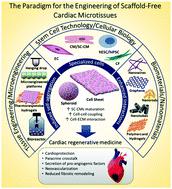当前位置:
X-MOL 学术
›
J. Mater. Chem. B
›
论文详情
Our official English website, www.x-mol.net, welcomes your
feedback! (Note: you will need to create a separate account there.)
Three-dimensional scaffold-free microtissues engineered for cardiac repair.
Journal of Materials Chemistry B ( IF 6.1 ) Pub Date : 2020-07-21 , DOI: 10.1039/d0tb01528h Alejandra Patino-Guerrero 1 , Jaimeson Veldhuizen , Wuqiang Zhu , Raymond Q Migrino , Mehdi Nikkhah
Journal of Materials Chemistry B ( IF 6.1 ) Pub Date : 2020-07-21 , DOI: 10.1039/d0tb01528h Alejandra Patino-Guerrero 1 , Jaimeson Veldhuizen , Wuqiang Zhu , Raymond Q Migrino , Mehdi Nikkhah
Affiliation

|
Cardiovascular diseases, including myocardial infarction (MI), persist as the leading cause of mortality and morbidity worldwide. The limited regenerative capacity of the myocardium presents significant challenges specifically for the treatment of MI and, subsequently, heart failure (HF). Traditional therapeutic approaches mainly rely on limiting the induced damage or the stress on the remaining viable myocardium through pharmacological regulation of remodeling mechanisms, rather than replacement or regeneration of the injured tissue. The emerging alternative regenerative medicine-based approaches have focused on restoring the damaged myocardial tissue with newly engineered functional and bioinspired tissue units. Cardiac regenerative medicine approaches can be broadly categorized into three groups: cell-based therapies, scaffold-based cardiac tissue engineering, and scaffold-free cardiac tissue engineering. Despite significant advancements, however, the clinical translation of these approaches has been critically hindered by two key obstacles for successful structural and functional replacement of the damaged myocardium, namely: poor engraftment of engineered tissue into the damaged cardiac muscle and weak electromechanical coupling of transplanted cells with the native tissue. To that end, the integration of micro- and nanoscale technologies along with recent advancements in stem cell technologies have opened new avenues for engineering of structurally mature and highly functional scaffold-based (SB-CMTs) and scaffold-free cardiac microtissues (SF-CMTs) with enhanced cellular organization and electromechanical coupling for the treatment of MI and HF. In this review article, we will present the state-of-the-art approaches and recent advancements in the engineering of SF-CMTs for myocardial repair.
中文翻译:

用于心脏修复的三维无支架微组织。
包括心肌梗塞(MI)在内的心血管疾病仍然是全世界死亡和发病的主要原因。心肌有限的再生能力对治疗 MI 以及随后的心力衰竭 (HF) 提出了重大挑战。传统的治疗方法主要依靠通过重塑机制的药理调节来限制对剩余存活心肌的诱导损伤或应激,而不是替换或再生受损组织。新兴的基于替代再生医学的方法侧重于通过新设计的功能性和生物启发的组织单元来恢复受损的心肌组织。心脏再生医学方法可大致分为三类:基于细胞的疗法、基于支架的心脏组织工程和无支架心脏组织工程。然而,尽管取得了重大进展,这些方法的临床转化仍受到成功替换受损心肌的结构和功能的两个关键障碍的严重阻碍,即:工程组织植入受损心肌的效果不佳以及移植细胞的机电耦合较弱与天然组织。为此,微米级和纳米级技术的整合以及干细胞技术的最新进展,为结构成熟且功能强大的基于支架(SB-CMT)和无支架心脏微组织(SF-CMT)的工程设计开辟了新途径。 )具有增强的细胞组织和机电耦合,用于治疗 MI 和 HF。在这篇综述文章中,我们将介绍用于心肌修复的 SF-CMT 工程的最先进方法和最新进展。
更新日期:2020-09-02
中文翻译:

用于心脏修复的三维无支架微组织。
包括心肌梗塞(MI)在内的心血管疾病仍然是全世界死亡和发病的主要原因。心肌有限的再生能力对治疗 MI 以及随后的心力衰竭 (HF) 提出了重大挑战。传统的治疗方法主要依靠通过重塑机制的药理调节来限制对剩余存活心肌的诱导损伤或应激,而不是替换或再生受损组织。新兴的基于替代再生医学的方法侧重于通过新设计的功能性和生物启发的组织单元来恢复受损的心肌组织。心脏再生医学方法可大致分为三类:基于细胞的疗法、基于支架的心脏组织工程和无支架心脏组织工程。然而,尽管取得了重大进展,这些方法的临床转化仍受到成功替换受损心肌的结构和功能的两个关键障碍的严重阻碍,即:工程组织植入受损心肌的效果不佳以及移植细胞的机电耦合较弱与天然组织。为此,微米级和纳米级技术的整合以及干细胞技术的最新进展,为结构成熟且功能强大的基于支架(SB-CMT)和无支架心脏微组织(SF-CMT)的工程设计开辟了新途径。 )具有增强的细胞组织和机电耦合,用于治疗 MI 和 HF。在这篇综述文章中,我们将介绍用于心肌修复的 SF-CMT 工程的最先进方法和最新进展。









































 京公网安备 11010802027423号
京公网安备 11010802027423号